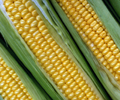Analysts toy with rare scenario for U.S. corn, soy acreage -Braun

Corn has always been the United States’ staple crop.
But American farmers have planted more soybeans than corn twice before, and that possibility is being considered for 2022 as soybean prices and corn production costs soar.
However, the classic saying that U.S. farmers “love to plant corn” seemingly proved true last year as traditional market signals may have indicated more soybean acres than were actually planted. High corn prices, which are even higher now, were likely too good to pass up and that might still be the case.
On average, market analysts believe U.S. farmers will plant more corn than soy in 2022, but the spread is close. A Reuters poll of 14 analysts this week placed corn acres at 91.8 million and beans at 89.2 million, and all but two had a larger corn area than beans.
That would be the second-largest soy area after 2017, and corn would be above the five-year average of 90.6 million acres. The estimates suggest a record corn-plus-soy area at just under 181 million acres, and 10 of the 14 analysts believed combined acres would best 2021’s high of 180.55 million.
Thirteen analysts see 2022 U.S. wheat acres at 47.8 million, and 11 of the predictions are above last year’s 46.7 million. It is unclear if analysts have made cuts to other crops to accommodate more total corn, soybeans and wheat or if they are assuming a larger acreage universe.
The U.S. Department of Agriculture is thinking along the same lines as it penciled in a 2022 area increase for the top three U.S. crops back in October. That included 92 million acres of corn, 87.5 million of soy and 49 million of wheat.
USDA will publish tentative U.S. balance sheets for 2022-23 on Thursday at 7 a.m. EST (1200 GMT). Those will include fresh area estimates derived in a way similar to those of other analysts, using factors such as economics. The results of the first U.S. planting survey will be published on March 31.
SOY’S FIRST VICTORY
Prior to 2017, corn area accounted for about 54% of the combined U.S. corn and bean total, which averaged nearly 174 million acres. Sinking corn prices and surging Chinese soybean demand in late 2016 shifted planting potential for the top two U.S. crops.
In 2017, combined corn and soy acres topped 180 million for the first time as the No. 3 crop, wheat, continued to lose ground. Corn acres narrowly topped soy in 2017, but soybeans took the slight edge in 2018.
That was the only time U.S. farmers planted more soybeans than corn in a natural, market-driven manner. Soy acres beat corn in 1983, but that was because of a government policy to reduce corn acres, a move that backfired due to historic drought that summer.
The most obvious link between 2017 and 2018 was the elevated price of new-crop Chicago soybean futures relative to new-crop corn in the months prior to planting. That new-crop ratio, November soybeans versus December corn, can often indicate better profitability for soybeans over corn when the value is around 2.5 or greater.
The ratio averaged near 2.6 in early 2017 and 2018, and U.S. soybean acres ended up significantly higher in those years than ever before. However, an identical ratio in 2021 produced different results.
A CASE FOR CORN?
Market participants a year ago pegged 2021 U.S. corn plantings at 92.9 million acres and soybeans at a strong 89.4 million, reasonable based on the elevated new-crop ratio. But final soybean acres landed at 87.2 million versus corn at 93.4 million.
The 2022 new-crop ratio has averaged 2.43 this month, above the 2.34 January average, out of soybean-favoring territory and well below last year. Some analysts are discounting the influence of the ratio this year because of increasing production costs of corn versus soybeans, a fair argument.
But 2022 will be a true test of just how much U.S. farmers love to plant corn despite those expensive inputs. Although futures suggested soybeans were more attractive than corn last year, analysts may have overlooked producers’ satisfaction with corn prices.
New-crop corn futures in February 2021, which represent the insurance guarantee to U.S. farmers, averaged $4.58 per bushel, a seven-year high. New-crop soybeans averaged $11.87 that month, an eight-year high.
This year’s contracts are much higher, setting new tops on Wednesday. November soybeans are averaging a record $14.32 per bushel this month and December corn is running at $5.89, slightly behind 2011’s benchmark of $6.01.
As of Wednesday, new-crop soybeans were trading 22% higher than on the same date last year and new-crop corn was up 30%.
MARKET SENTIMENT
There is some indication the social media mood may have shifted toward corn over beans since last fall, but plenty of uncertainty remains.
I asked readers via Twitter on Oct. 18 about 2022 U.S. corn plantings, and 40% of 573 voters chose 91 million acres or more. I asked about soybeans the next day and 39% of 405 voters chose 90 million or more. The response distribution suggested to me about 90.5 million corn acres and 89 million-90 million of beans.
Discussions around high fertilizer prices and shortages potentially reducing corn acres were very prominent in October. That theme has not necessarily faded, but futures prices are notably higher now. New-crop 2022 soybeans on Wednesday ended 21% higher than when the October poll was taken, and new-crop corn finished 16% higher.
I posted another Twitter poll on Jan. 20 asking about corn acres, and 61% of 1,086 voters saw corn acres above 91.5 million, including 24% at 93 million or more. I estimated a “trade average” of around 92 million corn acres from this survey, which if true would be very challenging for beans to match or exceed.
I did not poll for soybean acres on Jan. 20, but on Feb. 18 I asked whether corn or soybean acres would exceed the other, or if they would be equal. The winner among 998 votes was more corn acres than soy with 36%, but that means 64% saw the chance for beans to nearly equal or exceed corn area.
New-crop corn is up 9% since Jan. 20 and beans have jumped 13%, and it is clear that recent strength in both has complicated market participants’ acreage ideas. Fading attractiveness for spring wheat versus corn and beans may also lift the top crops’ planting possibilities.
Source: Reuters (Editing by Matthew Lewis)

 Hellenic Shipping News Worldwide Hellenic Shipping News Worldwide, Online Daily Newspaper on Hellenic and International Shipping
Hellenic Shipping News Worldwide Hellenic Shipping News Worldwide, Online Daily Newspaper on Hellenic and International Shipping





















 PG-Software
PG-Software